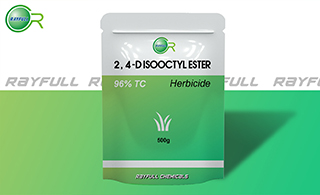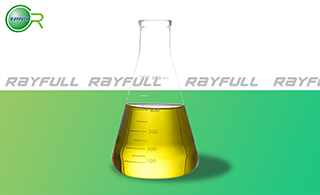2, 4-D ISOOCTYL ESTER
  2,4-өОТмРБхҘ 2,4-өОТмРБхҘ
Introduction: Selective post-emergence foliar treatment herbicide used to control annual or perennial broadleaf weeds, such as ,thistle, sonchus brachyotus in soybean, corn and wheat.
Common name: 2, 4-D Isooctyl Ester
Another name: Weedtrine-II, 2,4-D-isoctyl, Silvapron D, Esteron GE, Agroxone 5, Agro-D-Ester, Herbate Ester 80, Ded-weed sulv amine, 2,4-D isooctyl esters, 2,4-d, isooctyl ester, etc.
Chemical name: 6-methylheptyl 2-(2,4-dichlorophenoxy)acetate
Empirical formula: C16H22Cl2O3
Structural formula:

Mol. Weight: 333.249 g/mol
CAS No.: 25168-26-7
Specifications
Leading 2, 4-D Isooctyl Ester supplier
2, 4-D Isooctyl Ester 96% TC
Packing:
BULK PACKING
Solid: 25kg/Bag, 25kg/Drum, 50kg/Drum etc.
SMALL PACKING
Solid: 1kg/Alu bag, 500g/Alu bag, 200g/Alu bag, 100g/Alu bag, 50g/Alu bag, 15g/Alu bag etc.
Customerized packing label
Professional registration
HAZARDS IDENTIFICATION
Hazard statement(s)
H301 (11.54%): Toxic if swallowed.
H302 (88.46%): Harmful if swallowed.
H315 (11.54%): Causes skin irritation.
H317 (88.46%): May cause an allergic skin reaction.
H319 (11.54%): Causes serious eye irritation.
H351 (11.54%): Suspected of causing cancer.
H400 (88.46%): Very toxic to aquatic life.
H410 (88.46%): Very toxic to aquatic life with long lasting effects.
Precautionary statement(s)
P201: Obtain special instructions before use.
P202: Do not handle until all safety precautions have been read and understood.
P261: Avoid breathing dust/fume/gas/mist/vapors/spray.
P264: Wash ... thoroughly after handling.
P270: Do not eat, drink or smoke when using this product.
P272: Contaminated work clothing should not be allowed out of the workplace.
P273: Avoid release to the environment.
P280: Wear protective gloves/protective clothing/eye protection/face protection.
P281: Use personal protective equipment as required.
P301+P310: IF SWALLOWED: Immediately call a POISON CENTER/doctor/...
P301+P312: IF SWALLOWED: call a POISON CENTER/doctor/... IF you feel unwell.
P302+P352: IF ON SKIN: wash with plenty of water.
P305+P351+P338: IF IN EYES: Rinse cautiously with water for several minutes. Remove contact lenses if present and easy to do - continue rinsing.
P308+P313: IF exposed or concerned: Get medical advice/attention.
P321: Specific treatment (see ... on this label).
P330: Rinse mouth.
P332+P313: IF SKIN irritation occurs: Get medical advice/attention.
P333+P313: IF SKIN irritation or rash occurs: Get medical advice/attention.
P337+P313: IF eye irritation persists: Get medical advice/attention.
P362: Take off contaminated clothing.
P363: Wash contaminated clothing before reuse.
P391: Collect spillage.
P405: Store locked up.
P501: Dispose of contents/container to ...
Supplemental Hazard Statements: none
MAMMALIAN TOXICOLOGY
Acute toxicity: 1) Acute oral LD50 for rat: 982 a.i.mg/kg. 2) Acute dermal LD50 for rabbit: >4000 a.i.mg/kg.
Not classifiable as a human carcinogen.
ECOTOXICOLOGY
Acute 96 hour LC50 for Gammarus lacustr is 2400 ug/L. Acute 24 hour LC50 for Bluegill is 8.8 - 66.3 mg/L, acute 48 hour LC50 for Bluegill is 8.8 - 59.7 mg/L.
ENVIRONMENTAL FATE
2,4-D isooctyl ester's former production may have resulted in its release to the environment through various waste streams; it's use as a systemic herbicide will have resulted in its direct release to the environment. If released to air, a vapor pressure of 7.06ЎБ10-6 mm Hg at 25 deg C indicates 2,4-D isooctyl ester will exist in both the vapor and particulate phases in the ambient atmosphere. Vapor-phase 2,4-D isooctyl ester will be degraded in the atmosphere by reaction with photochemically-produced hydroxyl radicals; the half-life for this reaction in air is estimated to be 33 hrs. Particulate-phase 2,4-D isooctyl ester will be removed from the atmosphere by wet and dry deposition. Solutions of 2,4-D isooctyl ester absorb light > 290 nm, suggesting 2,4-D isooctyl ester may be susceptible to direct photolysis by sunlight. If released to soil, 2,4-D isooctyl ester is expected to have essentially no mobility based upon an estimated Koc of 29,000. Volatilization from moist soil surfaces is expected to be an important fate process based upon an estimated Henry's Law constant of 5.7ЎБ10-5 atm-cu m/mole. However, volatilization from moist soil surfaces is expected to be attenuated by adsorption to soil. In soil, the hydrolysis of 2,4-D isooctyl ester to 2,4-D and the alcohol was suggested to be microbially mediated. 2,4-D isooctyl ester was not detected after 3 years at an initial concentration of 560 ppm and application rate of 1,280 kg/ha. If released into water, 2,4-D isooctyl ester is expected to adsorb to suspended solids and sediment based upon the estimated Koc. Biodegradation is expected to be slow in water. Volatilization from water surfaces is expected to be an important fate process based upon this compound's estimated Henry's Law constant. Estimated volatilization half-lives for a model river and model lake are 20 hrs and 15 days, respectively. However, volatilization from water surfaces is expected to be attenuated by adsorption to suspended solids and sediment in the water column. An estimated BCF of 31,000 suggests the potential for bioconcentration in aquatic organisms is very high. However, like 2,4-D butyl ester, 2,4-D isopropyl ester may also be readily metabolized in fish and therefore should not bioconcentrate. 2,4-D isooctyl ester is expected to hydrolyze in solution. In distilled water, over 90% was recovered unchanged after 5 hours; this corresponds to a half-life of approximately 33 hrs. Hydrolysis of 2,4-D isooctyl ester to free anion in 0.1 N sodium hydroxide (pH 13.0) was almost instantaneous. Occupational exposure to 2,4-D isooctyl ester may have occurred through inhalation of aerosols containing 2,4-D isooctyl ester during spraying operations and dermal contact with sprayed vegetation. (SRC)
Usage: Selective post-emergence foliar treatment herbicide.
Application: Using 50% EC, 990-1320 mL/ha to control the broad-leaved weeds in the wheat field. Used to control the broad-leaved weeds in corn field, and the soil spraying was carried out by using 50% EC 1290-1830 mL/ha. To prevent and control weeds in soybean field, the soil spray was carried out with 50% EC 1140-1350 mL/ha.
| 






